第8讲核磁共振测井4
- 格式:pdf
- 大小:928.39 KB
- 文档页数:38
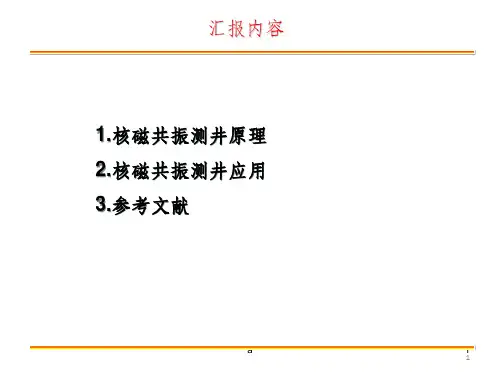
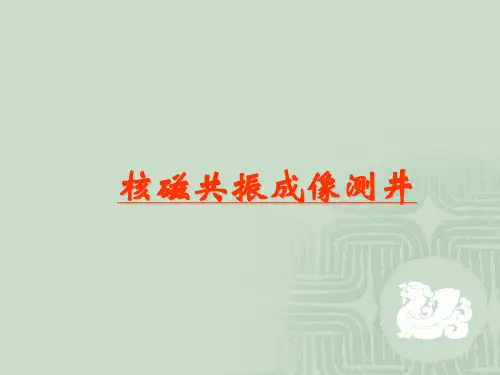
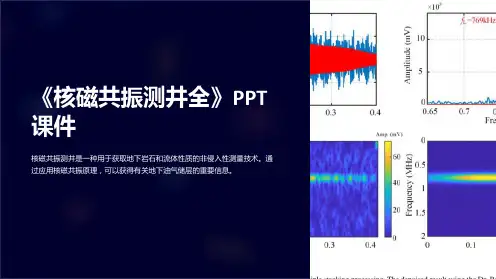
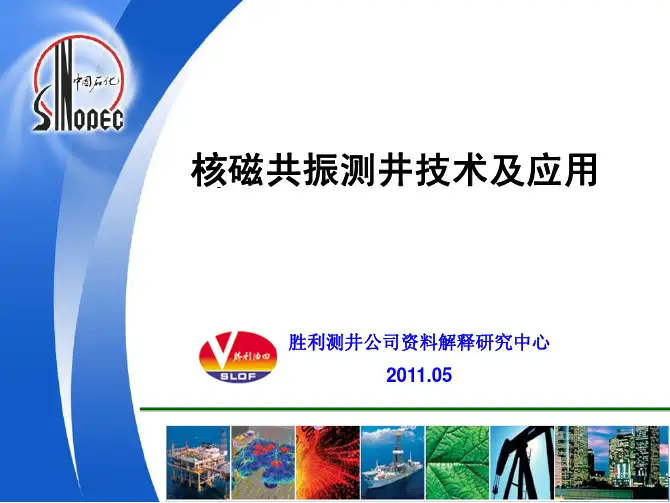
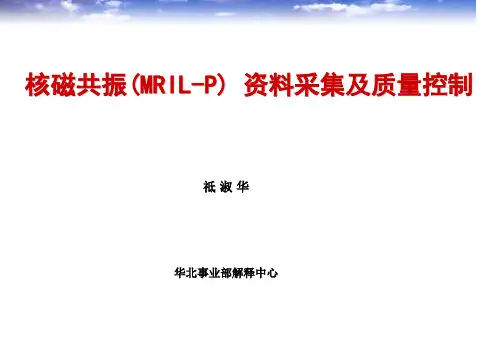
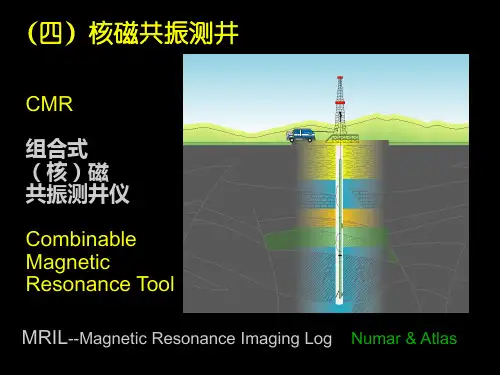
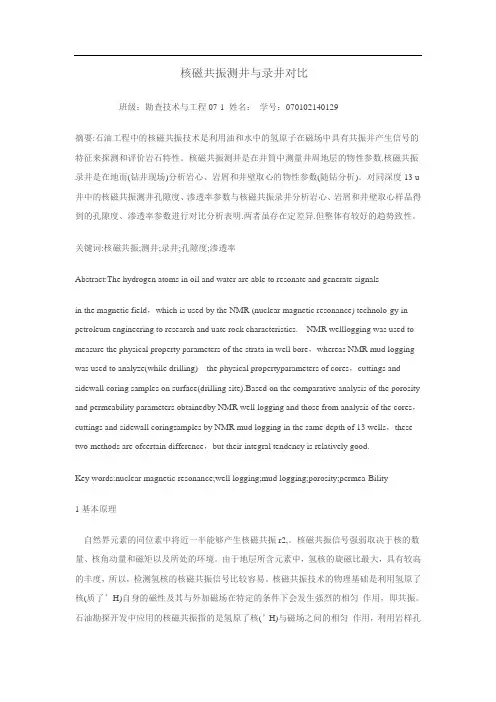
核磁共振测井与录井对比班级:勘查技术与工程07-1 姓名:学号:0701********摘要:石油工程中的核磁共振技术是利用油和水中的氢原子在磁场中具有共振并产生信号的特征来探测和评价岩石特性。
核磁共振测井是在井筒中测量井周地层的物性参数.核磁共振录井是在地而(钻井现场)分析岩心、岩屑和井壁取心的物性参数(随钻分析)。
对同深度13 u 井中的核磁共振测井孔隙度、渗透率参数与核磁共振录井分析岩心、岩屑和井壁取心样品得到的孔隙度、渗透率参数进行对比分析表明.两者虽存在定差异.但整体有较好的趋势致性。
关键词:核磁共振;测井;录井;孔隙度;渗透率Abstract:The hydrogen atoms in oil and water are able to resonate and generate signalsin the magnetic field,which is used by the NMR (nuclear magnetic resonance) technolo-gy in petroleum engineering to research and uate rock characteristics. NMR welllogging was used to measure the physical property parameters of the strata in well bore,whereas NMR mud logging was used to analyze(while drilling) the physical propertyparameters of cores,cuttings and sidewall coring samples on surface(drilling site).Based on the comparative analysis of the porosity and permeability parameters obtainedby NMR well logging and those from analysis of the cores,cuttings and sidewall coringsamples by NMR mud logging in the same depth of 13 wells,these two methods are ofcertain difference,but their integral tendency is relatively good.Key words:nuclear magnetic resonance;well logging;mud logging;porosity;permea-Bility1基本原理自然界元素的同位素中将近一半能够产生核磁共振r2,。
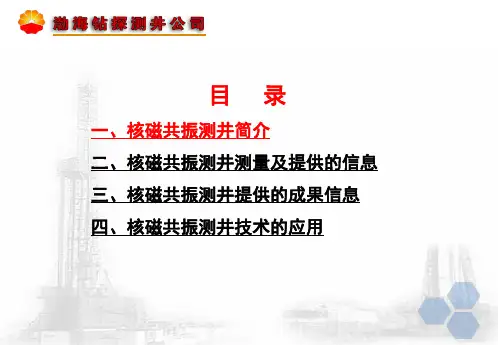
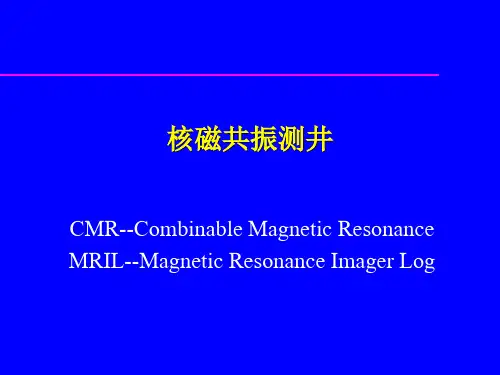
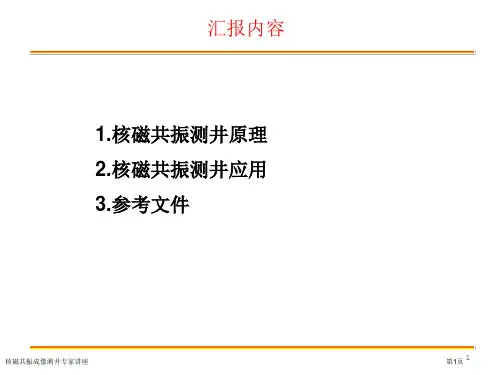

核磁共振测井技术原理及应用分析发布时间:2021-10-14T03:00:31.448Z 来源:《科学与技术》2021年16期作者:闫栋栋[导读] 随着科学技术的飞速发展,越来越多的新技术被运用到石油测井种,而核磁共振作为一种新兴手段,在石油测井中也起着重要的作用闫栋栋河北石油职业技术大学河北省承德市 067060摘要:随着科学技术的飞速发展,越来越多的新技术被运用到石油测井种,而核磁共振作为一种新兴手段,在石油测井中也起着重要的作用。
本文以核磁共振原理为落脚点,通过理论与实践的有机结合,探讨核磁共振技术如何合理地应用在石油测井中。
关键词:核磁共振;测井技术;石油测井引言:核磁共振测井技术相较于传统测井技术,不仅能够提供渗透率参数,还可以提供油气水饱和度、原油的黏度等。
本文首先概述核磁共振测井的发展现状,再简要介绍核磁共振测井技术的测量原理,最后进行核磁共振测井的应用分析。
一、核磁共振测井发展概况核磁共振测井技术作为一种新兴技术,是当代测井技术的重大突破之一。
现如今,我国陆地上石油勘探难度与日俱增。
尤其是中国地势经过数千年的演变后,地势情况愈加复杂,这也对勘探技术有了更高的要求。
就目前来看,我国东部地区仍存在许多未探明可采资源量,这些资源多分布在斜坡带、潜山、重力流砂体、滩海以及古生界等有潜力的新领域,已经为勘探工作带来诸多不便;而西部地区未探明油气资源高达55%,虽然有着巨大的潜力,但埋藏深、环境恶劣,勘探难度无疑是难上加难。
常规的测井方法已经无法满足也难以适应我国对油气使用增长的需求,进一步提高勘探技术,加速新技术的开发、研究、应用刻不容缓。
而核磁共振测井作为一种新兴方法,它的出现有效地攻克了这一难题,这也将成为未来油气勘探中重要的有效手段之一。
相较于传统测井方法的分辨率较低、直观性较差、解释油气层出现多解性,核磁共振测井最明显优势在于深探测、高分辨率和高精度。
二、核磁共振测井技术原理核磁共振测井的基本原理为“井内磁体——井外磁场测量”,这与传统测井方法是截然不同的。
核磁共振测井技术应用研究的发展一、快速发展的核磁共振测井技术1945年,Bloch 和Purcell发现了核磁共振(NMR)现象。
从那时起,NMR作为一种有活力的谱分析技术被广泛应用于分析化学、物理化学、生物化学,进而扩展到生命科学、诊断医学及实验油层物理等领域。
如今,NMR已成为这些领域的重要分析和测试手段。
40年代末,Varian公司证实了地磁场中的核自由运动,50年代,Varian Schlumberger-Doll,Chevron三个公司开展了核磁共振测井可行性研究。
60年代初开发出实验仪器样机,它基于Chevron研究中心提出的概念,仪器使用一些大线圈和强电流,在志层中产生一个静磁场,极化水和油气中的氢核。
迅速断开静磁场后,被极化的氢核将在弱而均匀的地磁场中进动。
这种核进动在用于产生静磁场的相同线圈中产生一种按指数衰减的信号。
使用该信号可计算自由流体指数FFI,它代表包含各种可动流体的孔隙度。
这些早期仪器有一些严重的技术缺陷首先,共振信号的灵敏区包括了所有的井眼流体,这迫使作业人员使用专门的加顺磁物质的泥浆和作业程序,以消除大井眼背景信号,这是一促成本昂贵且耗时冗长的处理,作业复杂而麻烦,测井速度慢石油公司难以接受。
其次,用强的极化电流持续20ms的长时间,减小了仪器对快衰减孔隙度成分的灵敏度,而只能检测具有长弛豫衰减时间的自由流体,由于固液界面效应对弛豫影响及岩石孔隙中油与水的弛豫时间差异不大,使得孔隙度和饱和度都很难求准。
此外,这些仪器为翻转被极化的自旋氢核需消耗大量功率,不能和其它测井仪器组合。
但这些难题没有使核磁共振测井研究中止。
70年代末至80年代初,美国Los Alamos国家实验室Jasper Jackson 博士提出“INSDE-OUT”磁场技术。
在相同时期,磁共振成象(MRI)概念也得到很大发展。
1983年,Melvin Miller博士在美国创办了NU-MAR公司,他们综合了“INSIDE-OUT”概念和MAR技术同时,斯伦贝谢公司几十年来,一直在努力发展核磁共振测井技术。
核磁共振测井资料解释与应用核磁共振测井(Nuclear Magnetic Resonance Logging,简称NMR 测井)是一种常用的地质测井技术,利用核磁共振原理对地下岩石进行非侵入性测量,可获取地层各种物理和化学参数的连续变化情况。
NMR测井资料是分析地层组成、孔隙结构和流体性质等信息的重要工具,在油气勘探、地下水资源评价和地质储层评价等领域有广泛的应用。
NMR测井资料提供了多个参数,包括有效孔隙度、孔隙尺度分布、孔隙直径、孔隙连通性和时间常数等。
根据这些参数,可以评估岩石孔隙结构特征,如孔隙度、孔隙分布、孔隙连通性,进而判断流体的储存和流动情况。
此外,NMR测井资料还可以提供岩石矿物组成信息,以及含油气饱和度、流体相态(油、气、水)比例和流体饱和度等。
NMR测井资料在油气勘探中的应用主要有以下几个方面:1.矿石特性评估:NMR测井资料可以获取到岩石的孔隙结构参数,如孔隙度、孔隙连通性等,进而评估储层的孔隙度分布、孔隙尺度、孔隙连通性等。
这些参数对于判断储层的储存和流动能力非常重要,对油气资源的评估和开发有着重要的指导意义。
2.资源评价和储量估算:NMR测井资料可以提供岩石中流体的类型、饱和度和流体饱和度等参数,这些参数对于评估油气资源的潜力和储量有着重要的作用。
结合地震和地质资料,可以对储层进行综合评价和储量估算,为油气勘探和开发决策提供科学依据。
3.储层评价和改造:NMR测井资料可以提供储层的孔隙结构参数,如孔隙度、孔隙连通性等,对于储层的评价和改造有着重要的作用。
通过对NMR测井资料的分析,可以确定储层的渗透率、孔隙度分布、孔隙连通性等,进而指导油气勘探和生产管理。
4.地下水资源评价:NMR测井资料可以提供地层中含水饱和度、孔隙结构和含水层分布等参数,对地下水资源的评价和开发有着重要的作用。
利用NMR测井资料,可以评估地下水资源的潜力和可开发性,从而指导地下水资源的开发和管理。
总之,NMR测井资料是一种重要的地质测井技术,可以提供地层的孔隙结构、流体性质和岩石组成等信息。